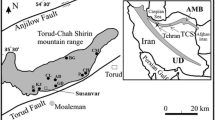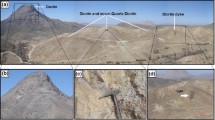Abstract
The U-statistic method is one of the most important structural methods to separate the anomaly from the background. It considers the location of samples and carries out the statistical analysis of the data without judging from a geochemical point of view and tries to separate subpopulations and determine anomalous areas. In the present study, to use U-statistic method in three-dimensional (3D) condition, U-statistic is applied on the grade of two ideal test examples, by considering sample Z values (elevation). So far, this is the first time that this method has been applied on a 3D condition. To evaluate the performance of 3D U-statistic method and in order to compare U-statistic with one non-structural method, the method of threshold assessment based on median and standard deviation (MSD method) is applied on the two example tests. Results show that the samples indicated by U-statistic method as anomalous are more regular and involve less dispersion than those indicated by the MSD method. So that, according to the location of anomalous samples, denser areas of them can be determined as promising zones. Moreover, results show that at a threshold of U = 0, the total error of misclassification for U-statistic method is much smaller than the total error of criteria of \(\bar {x}+n\times s\). Finally, 3D model of two test examples for separating anomaly from background using 3D U-statistic method is provided. The source code for a software program, which was developed in the MATLAB programming language in order to perform the calculations of the 3D U-spatial statistic method, is additionally provided. This software is compatible with all the geochemical varieties and can be used in similar exploration projects.












Similar content being viewed by others
References
Afzal P, Khakzad A, Moarefvand P, Rashidnejad Omran N, Esfandiari B and Alghalandis Y F 2010 Geochemical anomaly separation by multifractal modeling in Kahang (Gor Gor) porphyry system, central Iran; J. Geochem. Expl. 104 34–46.
Afzal P, Alghalandis Y F, Khakzad A, Moarefvand P and Rashidnejad Omran N 2011 Delineation of mineralization zones in porphyry Cu deposits by fractal concentration–volume modeling; J. Geochem. Expl. 108 220–232.
Cheng Q, Agterberg F P and Ballantyne S B 1994 The separation of geochemical anomalies from background by fractal methods; J. Geochem. Expl. 51 109– 130.
Cheng Q, Agterberg F P and Bonham-Carter G F 1996 A spatial analysis method for geochemical anomaly separation; J. Geochem. Expl. 56 183–I95.
Cheng Q, Bonham-Carter G F, Hall G E M and Bajc A 1997 Statistical study of trace elements in the soluble organic and amorphous Fe–Mn phases of surficial sediments, Sudbury Basin. 1. Multivariate and spatial analysis; J. Geochem. Expl. 59 27–64.
Cheng Q 1999 Spatial and scaling modelling for geochemical anomaly separation; J. Geochem. Expl. 65 (3) 175– 194.
Cheng Q, Yaguang X and Eric G 2000 Integrated spatial and spectrum method for geochemical anomaly separation; Nat. Resour. Res. 9 (1) 43–52.
Darabi-Golestan F, Ghavami-Riabi R, Khalokakaie R, Asadi H H and Seyedrahimi–Niaraq M M 2013 Interpretation of lithogeochemical and geophysical data to identify the buried mineralized area in Cu–Au porphyry of Dalli-Northern Hill; Arabian J. Geosci. 6 (11) 4499– 4509.
Ghannadpour S S and Hezarkhani A 2012 Developed software to calculate the additive constant number of average in three-variable normal logarithm; Global J. Comput. Sci. 2 (1) 7–13.
Ghannadpour S S 2013 Geochemical studies of porphyry copper ore deposit of Parkam, Tehran; MS Thesis, Amirkabir University of Technology.
Ghannadpour S S, Hezarkhani A and Eshqi H 2013a Average and variance estimation programming in normal logarithmic distribution; Global J. Comput. Sci. 2 (1) 1–6.
Ghannadpour S S, Hezarkhani A and Farahbakhsh E 2013b An investigation of Pb geochemical behaviour respect to those of Fe and Zn based on K-means clustering method; J. Tethys. 1 (4) 291–302.
Ghannadpour S S, Hezarkhani A and Farahbakhsh E 2013c Anomaly-background separation and geochemical map generation for Pb and Zn in Parkam district based on U-statistical method, Kerman, Iran; Int. J. Econ. Environ. Geol. 4 (2) 29–36.
Ghannadpour S S and Hezarkhani A 2015a Investigation of Cu, Mo, Pb and Zn geochemical behaviour and geological interpretations for Parkam porphyry copper system, Kerman, Iran; Arabian J. Geosci. 8 (9) 7273–7284.
Ghannadpour S S and Hezarkhani A 2015b Lead and zinc geochemical behaviour based on geological characteristics in Parkam porphyry copper system, Kerman, Iran ; J. Cent. South Univ. 22 4274–4290.
Ghannadpour S S, Hezarkhani A and Sabetmobarhan A 2015a Some statistical analyses of Cu and Mo variates and geological interpretations for Parkam porphyry copper system, Kerman, Iran; Arabian J. Geosci. 8 (1) 345–355.
Ghannadpour S S, Hezarkhani A, Maghsoudi A and Farahbakhsh E 2015b Assessment of prospective areas for providing the geochemical anomaly maps of lead and zinc in Parkam district, Kerman, Iran; Geosci. J. 19 (3) 431–440.
Ghannadpour S S, Hezarkhani A and Sabetmobarhan A 2015c The Parkam exploration district, Kerman, Iran: Geology alterations and delineation of Cu- and Mo-mineralized zones using U-spatial statistic with associated software development; J. Earth Sci., doi:10.1007/s12583-015-0644-6.
Ghavami–Riabi R, Seyedrahimi–Niaraq M M, Khalokakaie R and Hazareh M R 2010 U-spatial statistic data modeled on a probability diagram for investigation of mineralization phases and exploration of shear zone gold deposits; J. Geochem. Expl. 104 (1) 27–33.
Goncalves M A, Mateus A and Oliveria V 2001 Geochemical anomaly separation by multifractal modeling ; J. Geochem. Expl. 72 91–114.
Hezarkhani A and Ghannadpour S S 2015 Exploration information analysis; 1st edn, Amirkabir University of Technology (Tehran Polytechnic) Press, Tehran (in Persian).
Howarth R J and Earle S A M 1979 Application of a generalized power transformation to geochemical data; Math. Geol. 11 (1) 45–58.
Kramar U 1995 Application of limited fuzzy clusters to anomaly recognition in complex geological environments; J. Geochem. Expl. 55 81–92.
Li C, Ma T and Shi J 2003 Application of a fractal method relating concentrations and distances for separation of geochemical anomalies from background; J. Geochem. Expl. 77 167–175.
Miesch A T 1981 Estimation of the geochemical threshold and its statistical significance; J. Geochem. Expl. 16 49–76.
Müller U U, Schick A and Wefelmeyer W 2003 Estimating the error variance in nonparametric regression by a covariate-matched U-statistic; J. Theor. Appl. Stat. 37 (3) 179–188.
Peck R and Devore J L 2012 Statistics: The exploration and analysis of data; 7th edn, Brooks.
Roshani P, Mokhtari A R and Tabatabaei S H 2013 Objective based geochemical anomaly detection – Application of discriminant function analysis in anomaly delineation in the Kuh Panj porphyry Cu mineralization (Iran) ; J. Geochem. Expl. 130 65–73.
Sinclair A J 1991 A fundamental approach to threshold estimation in exploration geochemistry: Probability plots revisited; J. Geochem. Expl. 41 (1) 1–22.
Zuo R 2011 Identifying geochemical anomalies associated with Cu and Pb–Zn skarn mineralization using principal component analysis and spectrum-area fractal modeling in the Gangdese Belt, Tibet (China); J. Geochem. Expl. 111 13–22.
Author information
Authors and Affiliations
Corresponding author
Appendices
Appendix 1

Appendix 2

Rights and permissions
About this article
Cite this article
Ghannadpour, S.S., Hezarkhani, A. Introducing 3D U-statistic method for separating anomaly from background in exploration geochemical data with associated software development. J Earth Syst Sci 125, 387–401 (2016). https://doi.org/10.1007/s12040-016-0657-2
Received:
Revised:
Accepted:
Published:
Issue Date:
DOI: https://doi.org/10.1007/s12040-016-0657-2




